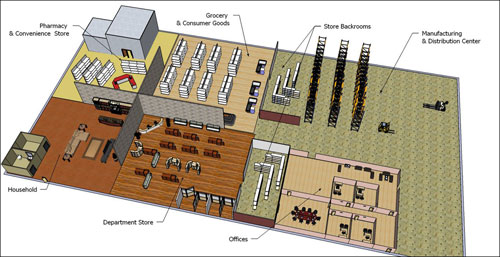When the University of Arkansas‘ Sam M. Walton College of Business opened its RFID Research Center in 2005, the facility consisted of a 7,500-square-foot space in which researchers, RFID companies and potential end users (more than 30 businesses in total) could begin testing radio frequency identification systems under the leadership of its director, Bill Hardgrave. The center’s replacement, slated to open this fall, will feature a full simulated supply chain for testing and tours.
Shortly after the RFID Research Center’s launch seven years ago (see University Opens RFID Research Center), it became the first academic lab to receive Performance Test Center accreditation from EPCglobal (see EPCglobal Certifies Gen 2 Hardware). Initially, the center did not accommodate tour groups, but as the community and companies began showing more interest in the work undertaken at that site, it eventually became open to such visitors. In those cases, guests could stand in the middle of the lab and turn from one direction to another, in order to view various RFID deployment scenarios, including a conveyor occupying half of the space.
Click here to view a larger version of the above diagram.
The center has already begun moving into a new larger facility that will allow tour groups to pass from one station to another, viewing a simulated environment employing RFID technology from end to end, from the receiving of raw materials at a manufacturing site to the deployment of RFID readers within a consumer’s home. “That’s one of the biggest advantages,” says Justin Patton, the research center’s managing director. “It has a flow for tours.”
The center’s design plans were announced earlier this week, and the official unveiling included speakers representing retailers that have utilized the center, such as Mike Graen, Wal-Mart Stores‘ director of store innovations. The center’s grand opening is scheduled for this fall. The new facility—located at 1637 Fred Hanna Drive, in Fayetteville—is situated near the former site, approximately a mile from the university’s campus, and is the center’s third location.“The University of Arkansas’ RFID Research Center’s research and technology evaluation capabilities have helped advance the industry’s understanding and performance of the Electronic Product Code (EPC),” Graen says. “The new center has the opportunity to enable greater research capability, standardization of evaluation and testing, and provide a forum for innovative thought.”
The new facility will measure 100 feet by 200 feet, and the manufacturing environment is set up on one end, leading to a distribution center, a store’s back room and three different sales floors (grocery/consumer goods, apparel/department store and pharmacy/convenience store). Finally, the center includes a model house. “This provides us with opportunities for testing technology in the home,” Patton says, such as RFID-enabled applications involving such things as medicines, groceries and recycling.
In addition, the new center includes office space for researchers, a conference room, and guest offices for companies that may visit to test RFID technology, or to view the results of testing conducted there. Some of those RFID firms have, in the past, included Tyco, Motorola, Checkpoint Systems, Smartrac and Avery Dennison. The building, unlike the former center, also offers climate control—since the former location had lacked air conditioning, summer days were often hot for visitors and researchers.
During the seven years since its opening, the RFID Research Center has been dedicated to researching EPC item-level tagging of goods for suppliers and retailers. In 2005, the facility was launched with the support of a research grant provided by Wal-Mart. The center has also partnered with a number of major retailers, including Dillard’s, JCPenney, Bloomingdales and Macy’s, all of which wished to research item-level RFID tagging for improved inventory accuracy. In 2008, the center released a report titled “RFID Item Level Tagging for Apparel/Footwear: Feasibility Study” (see New Research Papers from the University of Arkansas).The new facility signals a more mature RFID environment, Patton says, in which a larger testing center would be necessary to accommodate additional research and a growing number of visitors. “For the past couple of years now,” he states, “there’s been a real RFID industry developing, with money changing hands, and we’re starting getting beyond testing to field projects.”
Still, Patton says, for every retailer, there are unique demands requiring additional research before an appropriate solution can be developed. “You’d think two department stores with similar products might go down similar model paths,” Patton says. However, he adds, even small details, such as the frequency of cycle counts or the granularity of information needed, makes every deployment unique.
Most recently, the RFID Research Center has been focusing on a retailer and supplier return on investment (ROI) research project. This year, the lab is working on phase three of the project, which involves studying the transition of RFID-tagged goods passing from a supplier or distribution center to a retailer.
Phase 1 of the project consisted of 60 potential use cases, from raw materials to a DC’s outbound doors (see University of Arkansas Study Finds 60 Ways to Use RFID in Apparel Supply Chain). Phase 2 involved measuring the ROI gained via automated shipment accuracy for suppliers utilizing item-level RFID tagging (see RFID Study Quantifies ROI for Apparel Suppliers). The Phase 3 study will examine data transfer between suppliers and retailers, performing RFID-enabled inventory counts of goods as they leave a distribution centers and arrive at a retailer.




